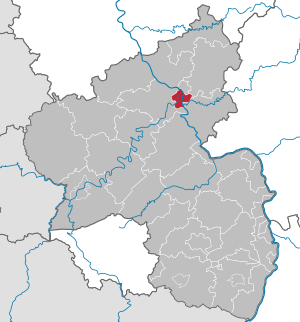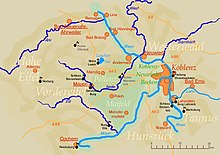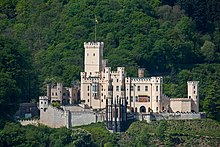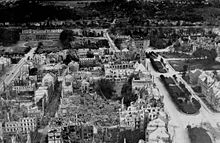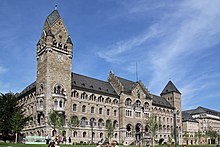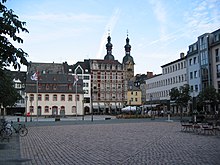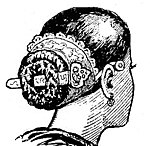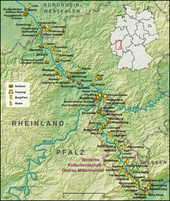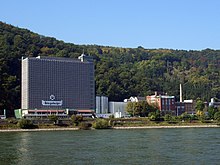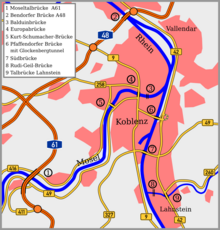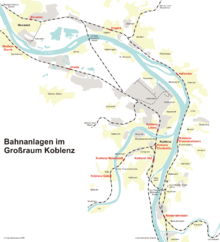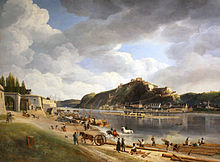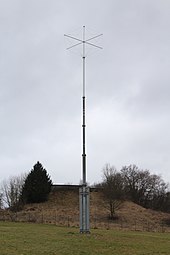Koblenz
| coat of arms | Germany map | |
|---|---|---|

|
Coordinates: 50 ° 21 ' N , 7 ° 36' E |
|
| Basic data | ||
| State : | Rhineland-Palatinate | |
| Height : | 73 m above sea level NHN | |
| Area : | 105.13 km 2 | |
| Residents: | 114,052 (Dec. 31, 2019) | |
| Population density : | 1085 inhabitants per km 2 | |
| Postcodes : | 56068-56077 | |
| Primaries : | 0261, 02606 | |
| License plate : | KO | |
| Community key : | 07 1 11 000 | |
| LOCODE : | DE KOB | |
| NUTS : | DEB11 | |
| City structure: |
30 districts , including 8 local districts |
|
City administration address : |
Willi-Hört-Platz 1 56068 Koblenz |
|
| Website : | ||
| Lord Mayor : | David Langner ( SPD ) | |
| Location of Koblenz in Rhineland-Palatinate | ||

Koblenz (until 1926 Coblenz ; dialect : Kowelenz ) is an independent city in northern Rhineland-Palatinate . With around 114,000 inhabitants, it is the third largest city in this state after Mainz and Ludwigshafen am Rhein and forms one of its five regional centers (the others are Trier and Kaiserslautern ). Koblenz ranks 68th among the largest cities in Germany .
Koblenz is the seat of the Koblenz campus of the Koblenz-Landau University , the RheinMoselCampus of the Koblenz University of Applied Sciences , the administration of the Mayen-Koblenz district , the North Structure and Approval Directorate ( Koblenz district government until 1999 ), the Federal Archives , the State Main Archives , and the Rhineland-Palatinate Constitutional Court as well as the Federal Office for Equipment, Information Technology and Use of the Bundeswehr .
Koblenz, which celebrated its 2000th anniversary in 1992, is one of the oldest cities in Germany . The original Latin name Confluentes ( German for the confluent ) was derived from the location of the city at the mouth of the Moselle and the Rhine at the so-called Deutsches Eck . In 1962 Koblenz passed the 100,000-inhabitant mark and thus became a major city .
Parts of Koblenz are part of the UNESCO World Heritage : since 2002 the city with its cultural monuments has been the northern gateway to the cultural landscape of the Upper Middle Rhine Valley , and Niederberg Castle has been on the UNESCO list since 2005 as part of the Upper Germanic-Rhaetian Limes . In 2011, the first Federal Horticultural Show in Rhineland-Palatinate took place in Koblenz .
The city has been a member of the Climate Alliance since 1997 .
geography
Geographical location
Koblenz is located on the Deutsches Eck , an estuary formed by the Moselle and Rhine. The closest major cities are Bonn (around 60 km down the Rhine), Wiesbaden and Mainz (around 90 km up the Rhine). Koblenz is bordered by the foothills of the Hunsrück in the south and the slightly hilly landscape of the Maifeld (foothills of the Eifel ) in the west. The districts to the right of the Rhine in the east of the urban area lie in the foothills of the Westerwald and, with some steep slopes, extend right up to the river.
The districts between the Moselle and the Rhine in the south are partially forested with lush mixed trees and form the “green lung” and the recreational area of Koblenz. This section of the Rhine belongs to the Middle Rhine .
Koblenz is stated to the Federal Agency for Cartography and Geodesy at 73 m above sea level. NHN . The Deutsches Eck is 64.7 m high. The highest elevation located entirely in the urban area is the Kühkopf in the urban forest at 382 m . The highest point of the urban area with 385 m is located on the border with the city of Rhens on the northern slope of the Mulberry Head, whose 395 m high peak is located in the Rhens city area.
Neighboring communities

The independent city of Koblenz borders on three districts:
- in the northeast to the Westerwaldkreis ( Simmern and Eitelborn ),
- in the east to the Rhein-Lahn-Kreis ( Lahnstein , Fachbach and Mialen ) and
- in the south, west and north to the district of Mayen-Koblenz ( Rhens , Waldesch , Dieblich , Winningen , Kobern-Gondorf , Mülheim-Kärlich , Kaltenengers , Urmitz , St. Sebastian , Bassenheim , Niederwerth , Vallendar , Bendorf and Urbar ).
In the vicinity of the city there is also the district of Neuwied in the north and the Rhein-Hunsrück district in the south .
City structure

The urban area of Koblenz is divided into 30 (statistical) districts . The division took place within the framework of the small-scale structure on the recommendation of the German Association of Cities . A special feature of these were the Charterhouse , which statistically Karthause North , Karthause-airfield and Carthusian yard area and the Southern suburbs , which statistically in mid and south is divided. The Carthusian monastery and the southern suburb, on the other hand, have historically emerged from uniformly grown structures and are only viewed as a district by the population as a whole. However, there is no resolution by the City Council of Koblenz on the status of a district of these statistical subdivisions.
Nine city districts form a total of eight local districts , whose concerns are represented to the city by a local advisory board and a local councilor. The remaining 21 districts have no local councils.
The 30 districts of Koblenz are Altstadt , Arenberg (local district together with Immendorf), Arzheim (local district), Asterstein , Bubenheim (local district), Ehrenbreitstein , Goldgrube , Güls with Bisholder (local district), Horchheim , Horchheimer Höhe , Immendorf (local district together with Arenberg ), Karthause (with the statistical districts of Karthaus Nord , Karthaus-Flugfeld and Karthäuserhofgelände ), Kesselheim (district), Lay (district), Lützel , Metternich , Moselweiß , Neuendorf , Niederberg (with Neudorf), Oberwerth , Pfaffendorf , Pfaffendorfer Höhe , Rauental , Rübenach (local district), Stolzenfels (local district), Südliche Vorstadt (with the statistical districts center and south ) and Wallersheim .
climate
Koblenz lies in the so-called temperate zone with a moderately cool climate and prevailing westerly winds. In the West German lowlands and the Rhine Rift, these winds bring about 700 mm of precipitation annually from the Atlantic and the North Sea. Koblenz is humid all year round with an average annual temperature of 10.8 ° C and an annual rainfall of 674 mm . The rainfall is low. They are in the lower quarter of the values recorded in Germany. Lower values are registered at 23% of the measuring stations of the German Weather Service . The driest month is February, with the most rainfall in July. In July there is 2.4 times more rainfall than in February. The rainfall varies greatly. Lower seasonal fluctuations are recorded at 72% of the measuring stations. Coldest month is January with a temperature of 2.7 ° C, warmest month July with an average of 19.5 ° C. The heat record is 39.4 ° C and was measured on June 18, 2002 in Koblenz. Due to its location in the valley of the surrounding low mountain ranges Eifel, Hunsrück and Westerwald as well as the proximity of three rivers (Rhine, Moselle, Lahn), Koblenz often has a "boiler climate" that is often quite humid compared to the surrounding area in summer. In the autumn and winter months, thick layers of fog are not uncommon, while on the heights of the low mountain ranges there is a cloud-free sky.
|
Average monthly temperatures and rainfall for Koblenz
|
||||||||||||||||||||||||||||||||||||||||||||||||||||||||||||
story
In the course of its history, Koblenz belonged to different regional authorities :

The history of the city of Koblenz is very changeable and characterized by armed conflicts in numerous border conflicts as well as a major structural change. The area of Koblenz has been settled since the Stone Age . The Romans built a fortified urban settlement here for the first time. The Fort Confluentes was built in today's old town center to secure the Roman Rhine Valley Road (Mainz – Cologne – Xanten) and in Niederberg the Niederberg fort to secure the Limes and the first bridges over the Rhine and Moselle . Koblenz is one of the oldest cities in Germany . After the withdrawal of the Roman troops in the 5th century, Koblenz was conquered by the Franks , who founded a royal court here . In the 836 consecrated Kastorkirche 842 negotiations took place between the three grandsons of Charlemagne held that ultimately the division of the Frankish Empire in the Treaty of Verdun led 843rd
During the reign of the Archbishops and Electors of Trier, Koblenz continued to flourish and a large number of cultural treasures arose in the form of churches, castles and fortifications. The Ehrenbreitstein Fortress gradually emerged from the castle built on the Ehrenbreitstein around 1020 . In uncertain times, the greatest sanctuaries were kept in this safest castle in the electoral state. In the 12th century the Archbishops of Trier built the Florins Church and the Church of Our Lady . In the 13th century, the Stolzenfels Castle was built as an electoral customs castle on the Rhine and the Old Castle as a fortress against citizens striving for more independence. In the following century, with the construction of the Balduin Bridge, a permanent Moselle crossing was made possible for the first time since the Romans. During the Thirty Years' War , Elector Philipp Christoph von Sötern moved his official residence from Trier to the newly built Philippsburg Palace at the foot of the Ehrenbreitstein, which has now been converted into a fortress. In 1786, Elector Clemens Wenzeslaus of Saxony moved to the Electoral Palace in Koblenz. From here he ruled the electoral state until its end in 1794, when the country and Koblenz were conquered by the French revolutionary army . From 1789 to 1794 (and then to the Ehrenbreitstein fortress until 1799), counter-revolutionary forces around the brothers of Louis XVI. withdrew to Koblenz and, thanks to her uncle Wenzeslaus, managed it relatively independently as "Little Paris" until it was conquered by Severin Marceau .
The following French period shaped Koblenz ( French Coblence ) far beyond its end. The term Schängel emerged , which is still used to describe everyone who was born in Koblenz. In the Treaty of Lunéville in 1801, Koblenz also formally fell to France and became the capital of the French Department de Rhin-et-Moselle . The end of this French era came in 1814 with the occupation of Koblenz by Russian troops.
Through the Congress of Vienna in 1814/15, the Rhenish properties of the Trier electoral state, and thus Koblenz, were transferred to Prussia . The city, initially the seat of the Upper Presidium of the Grand Duchy of Lower Rhine Province , later the capital of the Prussian Rhine Province , was developed as the Koblenz Fortress into one of the strongest fortress systems in Europe. In the 19th century, not only were mighty fortifications built in Koblenz, Stolzenfels Castle was also rebuilt and a ship bridge now crossed the Rhine . The first railway entered Koblenz in 1858 over the newly built Moselle railway bridge . With the subsequent expansion of the railway network, with the construction of the Pfaffendorfer Bridge , the Güls Railway Bridge and the Horchheim Railway Bridge , further crossings were made over the Rhine and Moselle. Due to the advancing military technology, the fortresses lost their importance from the second half of the 19th century. Since 1890 the city fortifications were completely demolished and the settlement area could now be expanded beyond the narrow city limits for the first time. In honor of Kaiser Wilhelm I , who had lived in Koblenz with his wife Augusta for a long time before his accession to the throne, the Kaiser Wilhelm monument was inaugurated at the Deutsches Eck in 1897 in the presence of Kaiser Wilhelm II at the mouth of the Moselle .
The 20th century was characterized by major structural changes and a considerable expansion of the settlement area. The Sacred Heart Church was consecrated on the site of the former Löhrtor in 1903 . A year earlier, a magnificent main train station was completed in the new southern suburb . After the end of World War Koblenz was only by American and French troops occupied . In 1932, the complete reconstruction of the Pfaffendorfer Bridge began, from which a completely new construction to a road bridge emerged. Two years later, a new Moselle crossing was inaugurated , as the Balduin Bridge was no longer sufficient for the growing volume of traffic.
Were incisive in the Second World War, the bombing of Koblenz , where the city was destroyed to 87%. In 1944, Lancaster bombers of the British Royal Air Force reduced the center of Koblenz to rubble and ashes. On March 18 and 19, 1945, the 87th US Infantry Division of the US Army took Koblenz. The city slowly recovered from the war events, but the historical cityscape remains partially lost. In the post-war period Koblenz came to the French zone of occupation and, as a result, to the new state of Rhineland-Palatinate . In the early years it was also the provisional seat of government. At the Rittersturz Conference in 1948, one of the fundamental decisions was made for the merger of the three western zones of occupation (“ Trizone ”) to form the Federal Republic of Germany and thus for the temporary separation from the Soviet zone. As a result of the West German rearmament since the mid-1950s, Koblenz again received a very large German garrison . The last parts of the French garrison withdrew in 1969. Koblenz passed the 100,000 mark in 1962, making it a major city . A major bridge construction project was completed with the completion of the south bridge in 1975. During the construction of the Rhine bridge, there were two tragic accidents in which 19 workers were killed. In 1992 the city of Koblenz celebrated the 2000th anniversary of the city's foundation.
On December 4, 2011, around 45,000 residents had to leave their homes . The reason for the most extensive evacuation of a German city after 1945 was to defuse some weapons ; including a British WWII aerial mine .
Incorporations
Formerly independent communities and districts that were incorporated into the city of Koblenz:
| year | places | Increase in ha |
year | places | Increase in ha |
|
|---|---|---|---|---|---|---|
| July 1, 1891 | Neuendorf with Lützel | 547 | 7th June 1969 | Kesselheim | 484 | |
| April 1, 1902 | Moselle white | 382 | 7th June 1969 | Kapellen-Stolzenfels | 248 | |
| October 1, 1923 | Wallersheim | 229 | November 7, 1970 | Arenberg-Immendorf | 900 | |
| July 1, 1937 | Ehrenbreitstein | 120 | November 7, 1970 | Arzheim | 487 | |
| July 1, 1937 | Horchheim | 772 | November 7, 1970 | Bubenheim | 314 | |
| July 1, 1937 | Metternich | 483 | November 7, 1970 | Güls with bisholder | 795 | |
| July 1, 1937 | Niederberg | 203 | November 7, 1970 | Lay | 249 | |
| July 1, 1937 | Pfaffendorf with Asterstein | 369 | November 7, 1970 | Rübenach | 1288 |
Population development
Through numerous incorporations, the city's population doubled from 45,000 in 1900 to 91,000 in 1939. During the Second World War, Koblenz lost around 80% of its inhabitants due to the almost complete destruction of the city. In April 1945, 19,076 card recipients were identified throughout the city by the food office. In 1958 the population reached the pre-war level again. In 1961, the city's population exceeded 100,000, making it a major city .
On November 7, 1970, the population of the city rose by almost 20,000 people to around 120,000 people due to the incorporation of several localities - a historic high. In 2004, the share of non-German residents in the total population was 9.3% (10,021 people), according to the city administration. Citizens from Turkey (1963), Ukraine (872), Serbia and Montenegro (785) and Russia (711) make up the largest proportion of this. At the end of June 2005, 106,501 people had their main residence in Koblenz, according to an update by the Rhineland-Palatinate State Statistical Office . After that, especially after the National Garden Show in 2011, the number of inhabitants rose steadily again and exceeded the 110,000 mark on May 31, 2014, the highest level since 1992.
The following overview shows the number of inhabitants according to the respective territorial status. Up to 1833 these are mostly estimates, then census results (¹) or official updates by the respective statistical offices or the city administration itself. From 1843 onwards, the information relates to the “local population”, from 1925 to the resident population and since 1987 to the “Population at the place of the main residence”. Before 1843, the number of inhabitants was determined according to inconsistent survey methods.
| year | Residents |
|---|---|
| 1469 | 1,193 |
| 1663 | 1,409 |
| 1778 | 7,475 |
| 1800 | 7,992 |
| 1808 | 11,077 |
| 1812 | 11,793 |
| 1820 | 11,324 |
| 1836 | 13,307 |
| December 1, 1840 ¹ | 18,387 |
| December 3, 1846 ¹ | 19,475 |
| December 3, 1852 ¹ | 22,033 |
| December 3, 1861 ¹ | 22,175 |
| December 1, 1871 ¹ | 24,902 |
| December 1, 1875 ¹ | 29,300 |
| year | Residents |
|---|---|
| December 1, 1880¹ | 30,500 |
| December 1, 1885 ¹ | 31,669 |
| December 1, 1890¹ | 32,664 |
| December 2, 1895 ¹ | 39,639 |
| December 1, 1900 ¹ | 45.147 |
| December 1, 1905 ¹ | 53,897 |
| December 1, 1910¹ | 56,487 |
| December 1, 1916 ¹ | 49,421 |
| December 5, 1917 ¹ | 50,067 |
| October 8, 1919 ¹ | 56,676 |
| June 16, 1925 ¹ | 58.161 |
| June 16, 1933 ¹ | 65,257 |
| May 17, 1939 ¹ | 91,098 |
| December 31, 1945 | 47,982 |
| year | Residents |
|---|---|
| October 29, 1946 ¹ | 52,414 |
| September 13, 1950 ¹ | 66,444 |
| September 25, 1956 ¹ | 84,275 |
| June 6, 1961 ¹ | 99,240 |
| December 31, 1965 | 103.425 |
| May 27, 1970 ¹ | 101,374 |
| December 31, 1973 | 120,564 |
| December 31, 1975 | 118.394 |
| December 31, 1980 | 113,676 |
| December 31, 1985 | 110,843 |
| May 25, 1987 ¹ | 108,246 |
| December 31, 1990 | 108,733 |
| December 31, 1995 | 109.219 |
| December 31, 2000 | 107,950 |
| year | Residents |
|---|---|
| June 30, 2005 | 106.501 |
| December 31, 2006 | 106,421 |
| December 31, 2010 | 106.501 |
| May 9, 2011 ¹ | 107,825 |
| May 31, 2013 | 109.209 |
| May 31, 2014 | 110.002 |
| December 31, 2014 | 111,434 |
| December 31, 2015 | 112,586 |
| December 31, 2016 | 113,605 |
| December 31, 2017 | 113,844 |
¹ census result
politics
Historical
At the head of the city of Koblenz was the mayor in the time of the electorate , who became a sovereign official from 1253. There was also a city council, which was subordinate to a bailiff in the 16th century. At the end of the 18th century, when the city was occupied by the French, it received the Mairie constitution with a Maire at its head. Koblenz was also the seat of the Prefect of the Department de Rhin-et-Moselle . After the transition to Prussia in 1815, a mayor headed the city administration . The city became the seat of the Rhine Province , headed by the High President . It also became the seat of the Koblenz district. In 1856 the Prussian town order was introduced. Up until this point in time, the communities of Neuendorf, Moselweiß and Kapellen-Stolzenfels also belonged to the Koblenz mayor. On October 1, 1887, Koblenz became an independent city , which it still is in the state of Rhineland-Palatinate to this day . For many years the King's Chair in Rhens was the place where the Koblenz mayors received their chain of office .
City council
The Koblenz city council consists of 56 honorary council members and the full-time mayor as chairman. The council members are re-elected every five years. The last city council elections took place on May 26, 2019.
| Election year | CDU | SPD | Green | FDP | FBG | left | BIZ | FW | AfD | SfK | WGS | total |
Voter turnout (in percent) |
|---|---|---|---|---|---|---|---|---|---|---|---|---|---|
| 2019 | 14th | 11 | 15th | 2 | - | 3 | - | 4th | 4th | - | 3 | 56 | 57.7 |
| 2014 | 21st | 14th | 8th | 2 | 3 | 2 | 3 | - | 2 | 1 | - | 56 | 47.8 |
| 2009 | 19th | 14th | 6th | 5 | 5 | 1 | 6th | - | - | - | - | 56 | 45.3 |
| 2004 | 25th | 17th | 5 | 4th | 5 | - | - | - | - | - | - | 56 | 48.3 |
| 1999 | 29 | 20th | 3 | 2 | 2 | - | - | - | - | - | - | 56 | 53.2 |
| 1994 | 24 | 23 | 5 | 2 | 2 | - | - | - | - | - | - | 56 | 68.2 |
|
Notes: FBG = Free Citizens Group Koblenz SfK = Schängel for Koblenz WGS = Voting Group Schupp |
|||||||||||||
Mayor since 1801

Since Koblenz is an independent city, the official title of the mayor is the mayor . This is elected by the citizens in a direct election for eight years. The penultimate election of the Lord Mayor took place on September 27, 2009 (at the same time as the Bundestag election ). Joachim Hofmann-Göttig , an independent candidate of the SPD, was elected to the office with 54.4 percent . He prevailed against his competitor Peter Labonte (CDU), Lord Mayor of the city of Lahnstein . The Lord Mayor took up office on May 1, 2010. His successor was determined in a runoff election on October 15, 2017: David Langner (SPD) was elected with 69.8% of the votes cast, his competitor Bert Flöck (CDU) had 30, 2%. Langner took office on May 1, 2018.
- 1801–1804: Peter Franz Elz
- 1804–1808: Johann Nikolaus Nebel
- 1808–1811: Johann Dominik Gayer
- 1812–1813: Emmerich Joseph von Eltz-Rübenach
- 1813–1814: Johann Josef Mazza
- 1814–1818: Johann Josef Mazza
- 1818–1847: Abundius Maehler
- 1847–1857: Friedrich Wilhelm Alexander Bachem
- 1857–1867: Hubert Josef Cadenbach
- 1867–1887: Karl Heinrich Lottner
- 1888–1900: Emil Schüller
- 1900–1914: Karl Ortmann
- 1915–1919: Bernhard Clostermann
- 1919–1931: Karl Russell , center
- 1931–1933: Hugo Rosendahl , center
- 1933–1939: Otto Wittgen , NSDAP
- 1939–1940: Theodor Habicht , NSDAP
- 1940–1945: Nikolaus Simmer , NSDAP
- 1945: Konrad Gorges , NSDAP
- 1945: Franz Lanters
- 1945–1946: Wilhelm Kurth , SPD
- 1946: Wilhelm Guske , SPD
- 1946–1960: Josef Schnorbach , CDU
- 1960–1972: Willi Werner Macke , CDU
- 1972–1994: Willi Hört , CDU
- 1994–2010: Eberhard Schulte-Wissermann , SPD
- 2010–2018: Joachim Hofmann-Göttig , SPD
- since 2018: David Langner , SPD
City Council
The city council consists of the mayor and the three councilors (mayor, cultural department and building department), which means that all four departments of the city administration are represented in the city council. The city council is chaired by the mayor, who is the only one to be determined in a primary election. The councilors, however, are elected by the city council. The mayor's name has been Ulrike Mohrs (CDU) since 2018. The cultural department has been headed by Margit Theis-Scholz since 2016 and Bert Flöck has headed the building department since 2016.
State and federal politics
At the state level, Koblenz is divided into two constituencies. All the districts of the city on the left bank of the Rhine belong to the Koblenz constituency . In the state elections in 2016 , the future mayor David Langner (SPD) won the direct mandate, and Anna Köbberling took up his position in the state parliament in May 2016 . Joachim Paul (AfD) was elected to the state parliament via the state list. The direct mandate in the constituency of Koblenz / Lahnstein , which includes the areas on the right bank of the Rhine, is currently held by Roger Lewentz (SPD).
At the federal level, the city is part of the Koblenz constituency . The directly elected member of parliament has been Josef Oster (CDU) since the 2017 federal election . In addition, Detlev Pilger (SPD), who was elected via the state list, is a member of the Bundestag.
coat of arms

|

|

|
| Blazon : "A continuous red bar cross in silver, topped with a golden crown with three long-stemmed diamond-clover prongs." | |
|
Reasons for the coat of arms: The city colors are red and white. The current coat of arms appears for the first time in the 14th century. The cross on a silver background stands for the coat of arms of the Archdiocese of Trier , to which Koblenz had belonged since 1018 and whose residence Koblenz-Ehrenbreitstein was around 1629 to 1786 and Koblenz from 1786 to 1794. The placed on the crossing point of the cross golden crown is the local coat of arms symbol and represents the Queen of Heaven Mary , the patron saint of the town, the parish church of " Our Lady is consecrated". |
In 1810 the city received a new coat of arms, which apparently never came into use. From 1814 Koblenz had the familiar coat of arms again.
During the time when Koblenz was a royal Prussian residence city (1850–1918), a variant of the coat of arms that is still in use today was used; with her a second, royal crown was placed over the coat of arms.
Twin cities
Koblenz has so far partnered with eight cities worldwide:
-
 Nevers ( France ), since 1963
Nevers ( France ), since 1963 -
 London Borough of Haringey ( United Kingdom ), since 1969
London Borough of Haringey ( United Kingdom ), since 1969 -
 Norwich (United Kingdom), since 1978
Norwich (United Kingdom), since 1978 -
 Maastricht ( Netherlands ), since 1981
Maastricht ( Netherlands ), since 1981 -
 Novara ( Italy ), since 1991
Novara ( Italy ), since 1991 -
 Austin ( Texas , United States ), since 1992
Austin ( Texas , United States ), since 1992 -
 Petah Tikva ( Israel ), since 2000
Petah Tikva ( Israel ), since 2000 -
 Varaždin ( Croatia ), since 2007
Varaždin ( Croatia ), since 2007
Climate emergency
On September 26, 2019, the Koblenz city council declared a climate emergency . With a narrow majority of the Greens, the SPD and the Left, he approved the relevant proposal.
Religions
Denomination statistics
At the end of October 2020, 16.2% of the residents (with main residence) were Protestant, 43.0% Roman Catholic and 40.9% belong to another religious community or are non-denominational.
Christianity
Catholic
The Catholics in Koblenz are organized in 29 parishes , which have joined together to form 5 parish communities and belong to the Koblenz deanery in the Diocese of Trier . A large number of Catholic associations such as the Social Service of Catholic Women (SkF), the Reading Association, the Kolping Society with the Kolping House, the DJK, youth associations (Boy Scouts, KSJ, KaJu) and institutions such as Caritas with their diverse social institutions and activities shape social life in Koblenz with. One of the three episcopal press offices is in Koblenz (next to Trier and Saarbrücken).
As a member of the Archbishopric of Trier ( Office and City of Coblenz ), the city of Koblenz was ruled by the Bishops of Trier for centuries .
Monasteries and orders in Koblenz
In the Arenberg district is the Arenberg Monastery , where the Arenberg Dominican Sisters (sisters of St. Catherine of Siena ) live. In the Pfarrer-Kraus-Anlagen between Arenberg and Immendorf, Pastor Johann Baptist Kraus created the landscape picture bible The holy places in Arenberg, called Red Rooster , which has been a listed building since 1987. The Bethlehem Monastery of the Poor Clares - Capuchin Sisters of Perpetual Adoration is in Pfaffendorf . The building of the monastery founded in 1904 by mother M. Ignatia von Herling was two-thirds destroyed in 1944 and has been inhabited again by the sisters since 1953. The Capuchin Monastery of Koblenz has been located in the Ehrenbreitstein district since 1628 . A convent of the Arnstein Fathers lives in the former Jesuit monastery on Jesuitenplatz . The Congregation of the Sisters of the Holy Spirit has been working in the Catholic Clinic Koblenz-Montabaur and its predecessors for over 150 years.
Evangelical
During the Reformation there were only a few Protestant parishioners in neighboring parishes. Through the Edict of Tolerance issued in 1784 by the Trier Elector Clemens Wenzeslaus of Saxony , wealthy Protestants were officially tolerated and their immigration permitted. In 1802 they received the chapel of the former Dominican convent of St. Martin in Görgengasse as a place of worship. When Koblenz became the capital of the Prussian Rhine Province in 1815 , the number of Protestant parishioners increased more strongly. In 1818, Friedrich Wilhelm III showed them . the earlier secularized Florinskirche , which he had expropriated from municipal property in exchange for compensation. In 1902 the Christ Church was finally built. The Protestant parishes are currently part of the Koblenz parish of the Evangelical Church in the Rhineland , provided they do not belong to a free church .
Other denominations
There are a number of other Christian communities in Koblenz. These are u. a. the Old Catholic parish of St. James, the Free Christian Congregation or the Christ Center, the Assemblée Évangelique de Koblenz, the Evangelical City Mission, the Free Evangelical Congregation, the Romanian Orthodox Church Community of Epiphany and the New Apostolic Congregation . The Old Catholic parish celebrates its services in the St. Jakobus Chapel at the Alten Hospital.
The denominations and communities represent their common interests in the Working Group of Christian Churches (ACK) Koblenz.
Judaism
Under French rule, the Consistoire Koblenz was created in 1808 , which regulated the internal affairs of the Jews . The Koblenz synagogue has been located in the Bürresheimer Hof , an aristocratic court from 1660, which was converted by the Koblenz master builder Johann Claudius von Lassaulx , since 1851. During the Reichspogromnacht of 9/10. In November 1938 the facility was completely devastated, as was the Jewish cemetery in the Rauental district.
In the mourning hall built there in 1925, services were held until the deportation. After the war, this hall was restored by French soldiers and has served as a synagogue and community center for the small community ever since . The Bürresheimer Hof, which was destroyed in the war, was rebuilt in its baroque form and served as a library until 2013. A memorial room for the victims of National Socialism was set up within the library. There is a plaque on the building to commemorate the synagogue.
Islam
Mosques are operated by the Islamic Association of the Turkish-Islamic Union of the Institute for Religion / DITIB (Emir Sultan Camii), the Association of Islamic Cultural Centers / VIKZ (Süleymaniye Camii), the Islamic Bosnian Community e. V. (Bosnian mosque) and the Pakistani community Pak Dar-ul-Islam e. V. (Aqsa Mosque). In addition, there is the “Association of Islamic Culture Koblenz”, which operated the only Arabic-speaking mosque in Koblenz until it was closed at the beginning of 2018 for legal reasons.
In May 2004, the Tahir Mosque of the Ahmadiyya Muslim Community was opened in the Lützel district . This is the first representative Islamic sacred building in Koblenz.
In 2015, the working group of Muslim communities was founded in Koblenz.
Culture and sights
theatre
- Café Hahn
- The Koblenz Ensemble
- Chamber plays
- Konradhaus (closed since 2014)
- Culture Factory (KuFa)
- Theater am Ehrenbreitstein
- Theater Koblenz
Museums

- DB Museum Koblenz
- Deinhard cellar museum
- House Metternich
- Landesmuseum Koblenz on the Ehrenbreitstein Fortress
- Ludwig Museum in the Deutschherrenhaus
- Middle Rhine Museum in the Forum Confluentes
- Mosellum at the Koblenz barrage
- Mother Beethoven House ( Beethoven Memorial)
- Rhein-Museum Koblenz , museum for cultural history and shipping
- Rhenish Carnival Museum in the throat tower of Fort Constantine
- Museum in Stolzenfels Castle
- Defense Technology Study Collection Koblenz (WTS)
- Romanticum Koblenz
- Permanent exhibition "Koblenz in World War II" in Fort Konstantin
music
Koblenz is known for its alternative music scene, from which bands and projects such as Blackmail , Desaster , KEN , Scumbucket , Hekate , Mill and Heldmaschine ( Völkerball ) emerged.
The internationally known festival for classical guitar Koblenz International Guitar Festival & Academy has been taking place in a row since 1993. The visitors can expect concerts, master classes, workshops, lectures and the guitar competition Koblenz International Guitar Competition "Hubert Käppel" .
Koblenz is also the seat of one of the three Rhineland-Palatinate state orchestras, the Rheinische Philharmonie State Orchestra . The orchestra, whose roots go back to 1654, plays in Koblenz a. a. eight large symphony concerts a year in the Rhein-Mosel-Halle , organized by the Koblenz Music Institute. Our own concerts take place in the Görreshaus in Koblenz's old town. The Görreshaus is the orchestra's rehearsal and concert hall and, with its historic Görressaal, is one of the most beautiful secular buildings on the Middle Rhine. The Rheinische Philharmonie has been performing all opera productions at the Koblenz Theater since 1945 .
The Alte Musik am Mittelrhein e. V. promotes and organizes concerts with early music , taking historical performance practice into account . The Cappella Confluentes and the Ensemble Cappella Musica Sacra play early music on original instruments of the respective time or on replicas that are true to the original.
The German Saxophone Ensemble is based in the village.
The Fanfarenzug Koblenz-Karthause , which has existed since 1964, brought the state championship of the regional association for minstrels to Koblenz in 2007 and won a silver medal. In 2009 this event took place again in Koblenz and in 2015 the Karthaus fanfare procession became two-time Rhineland-Palatinate champions. When it first took part in the German championships in Lindau / Harz in 2016, the Karthaus fanfare group won three German championship titles. Both the youth train and the senior train have been expanded in the natural tone class .
Palaces and castles

- Electoral Palace : Located on the Rhine and built from 1777 to 1793, the palace was the last residence of the Electors of Trier .
- Old Castle : The former electoral moated castle from the 13th century was built as a fortress against the Koblenz citizens striving for independence and today houses the city archive .
- Stolzenfels Castle : Built in the 13th century as a customs castle on the Rhine, it was destroyed by the French in 1689 during the War of the Palatinate Succession . It was rebuilt as a palace by the Prussian King Friedrich Wilhelm IV in the 19th century and has since been regarded as the most outstanding example of Rhine romanticism .
Former castles:
- Helfenstein Castle : Disappeared hilltop castle on the Ehrenbreitstein , which was built around 1160.
- Mühlenbach Castle : Disappeared Niederungsburg in the Arenberg district, which was built around 1300. The main tower of the former castle has been preserved.
Former castles:
- Philippsburg Palace : In the 17th century, Elector Philipp Christoph von Sötern moved the seat of government from Trier to the Rhine, under the protection of the most secure fortress in the electorate. After French revolutionary troops had conquered Koblenz, they blew up the Ehrenbreitstein fortress in 1801. The lock was so damaged that it had to be broken off.
- Schönbornslust Palace : Former hunting lodge in Kesselheim, built 1748–1752 by Elector Franz Georg von Schönborn . Destroyed in the course of the conquest by the French revolutionary troops in 1794 and finally completely demolished in 1806.
Fortresses
Some of the Prussian fortifications from the 19th century have been preserved in Koblenz. At that time, the Prussians expanded the city into one of the most extensive fortress systems in Europe. The Ehrenbreitstein Fortress still towers over the Rhine Valley as the successor to the electoral fortifications and is the only one of the structures from that time that has been almost completely preserved. Other buildings of the Koblenz Fortress have been partially preserved, such as the Grand Prince Konstantin Fort on the Karthauser , the Asterstein Fort on the Asterstein and the Emperor Franz Fortress in Lützel.
Sacred buildings
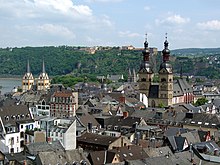
The oldest church building in Koblenz is the St. Kastor Basilica , which was built between 817 and 836 in Koblenz's old town . This church, in which German history was made, is worth seeing because of its extensively preserved Romanesque building stock and the largely traditional furnishings. Other important church buildings in the old town are the Kath. Liebfrauenkirche and the Evangelical Florins Church . These two churches go back to the 12th century and dominate the cityscape of Koblenz. The cath. The Jesuit Church of a former Jesuit college from the 17th century is the fourth church building in the old town.
With the abandonment of the city fortifications and the subsequent city expansion to the south at the end of the 19th century, the Catholic. Herz-Jesu-Kirche at the former Löhrtor, the cath. Church of St. Josef in the new southern suburb and the Christ Church , the first Protestant church building in Koblenz, on Friedrich-Ebert-Ring.
There has been a Jewish community in Koblenz since the Middle Ages . A synagogue existed in the Bürresheimer Hof in the heart of the old town until it was destroyed in the pogrom night of 1938 . Since the Second World War, the former cemetery hall at the Jewish cemetery in Rauental has been used as a house of prayer for the Jewish community.
In 2004, in Lützel the Tahir - Mosque (Mosque of the Pure), the first Muslim religious building, built; In 2012 the Aqsa Mosque in the same district .
Profane structures
- The landmarks of the city:
- Deutsches Eck : headland at the confluence of the Moselle and the Rhine; A monumental equestrian statue of Kaiser Wilhelm I was erected here in 1897 .
- Schängelbrunnen : a fountain erected in front of the town hall in 1940, which is a memorial to Koblenz Schängel , a rascal.
- Old coin : former mint master's house of the electoral coin on the Münzplatz .
- Old department store with electoral aldermen's house and Bürresheimer Hof on Florinsmarkt .
- Balduin Bridge : the second oldest surviving bridge over the Moselle from the 14th century.
- CGM arena .
- German Kaiser : late Gothic residential tower on the banks of the Moselle.
- Deutschherrenhaus : House of the Teutonic Order from the 13th century, today the Ludwig Museum is housed there.
- Dreikönigenhaus : today part of the city library is housed here.
- Building of the former Prussian government (so-called old government building) in the Rhine facilities , today the headquarters of the Federal Office for Equipment, Information Technology and Use of the Bundeswehr .
- Building of the High Presidium (= Provincial Government) of the Prussian Rhine Province in Stresemannstrasse, today the seat of the North Structure and Approval Directorate .
- House Metternich : Birthplace of the Austrian State Chancellor Prince Clemens von Metternich .
- Building of the former Imperial Post Office Directorate on Friedrich-Ebert-Ring, today the seat of the Rhineland-Palatinate Mobility Office .
- Historic town hall : former Jesuit college and grammar school from the 16th century.
- Kastorbrunnen : a curious testimony to the Napoleonic Wars in front of the St. Kastor Basilica.
- Koblenzer Hof : former grand hotel in the Rhine area.
- Kramerzunfthaus : former guild building of the merchants and the seat of municipal Mehlwaage.
- Martin-Gropius-Bau : authentic document of the brick building art of the Berlin School, built in 1878 by Martin Gropius and Heino Schmieden as a Prussian garrison hospital.
- Mother Beethoven House : Birthplace of Ludwig van Beethoven's mother in Ehrenbreitstein .
- Rhein-Mosel-Halle .
- Four towers : four corner houses in the old town with ornate bay towers from the 17th century.
- Weindorf Koblenz : a village-style restaurant in the Rheinanlagen , where wines from the German wine-growing regions are tasted.
Monuments
- Kaiser Wilhelm I monument at the Deutsches Eck
- Memorial of the German Army on the Ehrenbreitstein Fortress
- Friedrich Mohr monument in front of the Eichendorff grammar school
- History column on Joseph-Görres-Platz
- Johannes Müller monument on Jesuitenplatz
- Joseph Görres memorial in the Rheinanlagen
- Empress Augusta monument in the Rhine complex
- Memorial for the victims of National Socialism in Koblenz on Reichenspergerplatz
- Peter Altmeier monument in the Moselle area
- Rittersturz monument in memory of the Rittersturz conference
- Barbara monument (restoration autumn 2014)
Places
- On the plan
- Bahnhofplatz
- Clemensplatz
- Deinhardplatz with the Clemensbrunnen
- Florins Market
- Jesuitenplatz with the Johannes Müller monument
- Joseph-Görres-Platz with the history column
- Kapuzinerplatz with the Capuchin monastery and the level fountain
- Münzplatz with the birthplace of Prince Metternich and the Old Mint
- Reichenspergerplatz with the Koblenz memorial
- Willi-Hört-Platz (previously part of Gymnasialstraße) with the historic town hall and the Schängelbrunnen
- Central square
graveyards
There are 22 cemeteries in the Koblenz city area:
- Main cemetery . The central cemetery, founded in 1821 in the gold mine on the northern slope of the Karthauser , has the character of a landscape park. It is the resting place of some important people.
- There are smaller cemeteries in many of Koblenz's districts.
- The Jewish cemetery of Koblenz is located in the Rauental district .
- The Franzosenfriedhof , a military cemetery for deceased French prisoners of war with the Marceau memorial is located in the Lützel district .
Parks

The German Empress Augusta had the Rhine complex in Koblenz designed as a park from 1856 . She was also the patroness of the Catholic pastor Kraus and supported his efforts in the Arenberg district to create the Pfarrer-Kraus-Anlagen , a landscape picture Bible , named after him today . In the district of La Petite is located on the site of the former Flesche Bubenheimer the Lützeler public park .
The city of Koblenz was the venue for the 2011 Federal Horticultural Show . The area around the Deutsches Eck , with the park at the Deutsches Eck and the Paradise Garden in the Blumenhof, the Electoral Palace with the palace gardens and the Ehrenbreitstein Fortress were part of the event site. The fortress park, a spacious landscape park with a wooden viewing platform, was built on the square in front of the fortress. In order to connect the area at the Deutsches Eck with the plateau in front of the Ehrenbreitstein Fortress, the Rheinseilbahn, Germany's largest aerial cableway, was built. According to the state government, the 2011 Federal Horticultural Show was the largest event in the history of Rhineland-Palatinate. With a visitor number of over 3.5 million people, it was the most successful federal horticultural show since the introduction of the electronic counting system in 1997.
Nature reserves
In Koblenz there are the nature reserves Ice Age Loess Profile in the Metternich district and Tongrube on Escherfeld in the Horchheimer Höhe district.
Sports
There are around 150 Koblenz sports clubs with a total of 42,000 members; around 50 different sports are offered. Wheelchair dance, for example, can be enjoyed in the Wheelchair Sports Association (RSG) Koblenz e. V. exercise.
A well-known club in the city is the soccer club TuS Koblenz , until 1981 TuS Neuendorf or at times SpVgg Neuendorf . The club's most successful period was the post-war period, when the Neuendorfer reached the semi-finals of the German championship in 1948 after beating Hamburger SV , but were clearly inferior to 1. FC Kaiserslautern with several later world champions . The team also reached the semi-finals in the DFB Cup 1953/54 and was only defeated in the replay by the eventual title winner VfB Stuttgart . In 1968 and 1969 the gymnastics and game association took part in the promotion round to the Bundesliga , but failed both times quite clearly in promotion to the top German division . After decades of purely regional football, TuS played in the 2nd Bundesliga from 2006 to 2010 . In the meantime, the club only plays in the fifth-class Oberliga Rheinland-Pfalz / Saar and thus even a league lower than the neighboring Rot-Weiß Koblenz , which after decades has only been represented in the Regional League Southwest since 2019 on a local level . The home of both clubs is the Oberwerth stadium , which once had space for up to 40,000 spectators, but is now only approved for 9500 spectators, making it the largest sports facility in Koblenz. The Oberwerth sports school is available as a training and conference center in the immediate vicinity of the Oberwerth stadium for clubs and other associations.
The football coach Rudi Gutendorf is an outstanding personality in Koblenz sports . Active in the post-war period as a player in the heyday of TuS Neuendorf, he was best known as a coach. After several engagements in the Bundesliga and the Meidericher SV won runner-up , he trained for decades dozens of teams around the world and is regarded internationally as record holder with respect to the number of its different coach stations.
The Koblenz location is an Olympic base for fencing and rowing. The city was a stage stop on the Rhineland-Palatinate Tour and a stage destination of the Tour de France in 1992 . Koblenz was also the destination of the Middle Rhine Marathon , which ran from Oberwesel to the Deutsche Eck from 2005 to 2015 . The successor to the Middle Rhine Marathon is the Koblenz Sparkassen Marathon, which has been taking place in September 2017 and starts and ends in the Oberwerth stadium.
The Koblenz city forest is used for various kinds of sporting activities and the Rheinsteig hiking trail leads through Koblenz along the right bank of the Rhine .
In Koblenz there are five swimming pools, the Beatusbad in the gold mine, the school pool on the Karthauser, the outdoor pool on the Oberwerth, the outdoor pool in Stolzenfels and a soldiers pool in the Falckenstein barracks in Lützel. The public swimming pool in the old town was closed in 2012 and subsequently demolished.
The sports club in Koblenz with the largest number of members is the Koblenz section of the German Alpine Club with almost 6,000 members , which operates two huts , some paths and via ferratas.
Other large sports clubs in Koblenz are as follows:
Koblenz dialect
The dialect spoken in Koblenz , the so-called Kowelenzer Platt , belongs to the Moselle Franconian . It differs from other Rhenish dialects mainly in tone. The singing, even melodic speaking of the northern Rhinelander is opposed to a flat pitch with a particular preference for broad sounds and the extension of the sound duration in the Koblenz dialect ("dah" = you). In contrast to Limburg and Ripuarian dialects, the Moselle Franconian dialects are not tonal languages . In the past, but especially when it belonged to France (1794–1814), many French loanwords were also used, including Plümo ( feather bed ), Filou ( rascal ), Monnie ( money ), Drottewaar ( pavement ). It is interesting that the sound shifts differ from district to district, which often leads to a mixed dialect.
Koblenz has the oldest dialect word collection in the Rhineland . As early as 1787, J. H. von Bleul from Koblenz published a list of words in several series in the General Churtrier Intelligence Journal . With the New Dictionary of Koblenz Dialect, Hannelore Kraeber published a documented Koblenz language collection from over 200 years. This is considered a rarity among the dialect records.
An example of the Koblenz dialect is the Schängellied , the hymn of Koblenz, as well as the identity-creating video Dau bist Kowelenz from 2006, which can be understood as a parody of the campaign You are Germany .
dress
The virtue arrow is a specially shaped hairpin that was typical of Koblenz and the left bank of the Rhine until the beginning of the 20th century.
Koblenz Carnival
Since the 13th century, guaranteed by the Cistercian monk Caesarius, the carnival has been going on at the corner ; in the first few centuries under the gaze of strict church representatives, until the religiously motivated carnival is buried with the outbreak of the Thirty Years' War . Despite destruction, pillage and death, the Koblenz Carnival in 1688 managed to return to the city, which was now shaped by modern times. Splendor and electoral splendor determined its character until the city was handed over to Napoleonic France. The previously aristocratic carnival has now become a purely bourgeois event.
Napoleon's defeat and Prussia's rise from 1815 onwards mark another, probably the most important, section of the Koblenz carnival history: the carnival reform of 1823 that started in Cologne . The result of this reform is the institutionalization of the Koblenz carnival in 1824 and numerous associations being founded. Bourgeois stubbornness and the will to organize themselves were already at odds with the Prussian state of affairs, which paralyzed the further development of the fifth season at the beginning of the 19th century. Although the people of Koblenz succeeded in organizing their first carnival parade in 1827, the freedom to organize the event soon reached its bureaucratic limits.
It was only after 1860 that the fools and the authorities began to relax. The Koblenz Carnival is repeatedly interrupted by political crises and the lack of interest that emerged around the turn of the century. Because of its economic and tourist importance, the foolish hustle and bustle in Koblenz received an additional drive during the 1920s. Interrupted by the Second World War, interest has grown to the present day.
The Koblenz Carnival is kept alive today mainly through the committed community work of the Koblenz Carnival Working Group (AKK). Some of the most famous clubs in the Koblenz Carnival are the Great Koblenz Carnival Society of 1847 e. V., the KKG Red-White-Green “Kowelenzer Schängelcher” 1922 e. V., the K. K. Funken "Rot-Weiß" 1936 e. V., the fools guild “Yellow-Red” and the AHC. The AHC has existed since 1936, when the Koblenz merchant Willi Lescrinier founded this fool's association as the “Reserve Officer Corps” of the Prinzengarde Infantry of the Great Koblenz Carnival Society, became its commander and embodied Prince Carnival as “Prince Willi von Lescrinesien”. AHC means Alt-Herren-Corps. The most popular stops of the carnival, in addition to a variety of theater events and meetings of Rosenmontagszug through the entire city, the nomination and election of the prince and his "lady Confluentia" and the storming of the City Hall and the Falckenstein barracks by the Koblenz fools under the leadership of the penalty rate and the madness.
The principle that cannot be bought:
- Let's stick to the custom
- mindful of character
- that the world can only shape
- who preserves the values!
Culinary specialties
- Debbekooche ( Döbbekuchen )
- Dark
- Muffled
- Rhenish sauerbraten
- Schrottele - Lacquered Monkey - Sooßekardoffele
Regular events
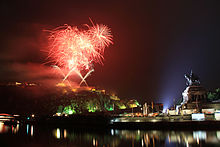

- February / March: Rose Monday parade (Carnival parade)
- March: Koblenz Literature Days with literature matinee
- April to September: wine village season
- April: Fortress lights in the Ehrenbreitstein Fortress
- April / May: Flower and wine festival in Koblenz- Güls
- May: May festival on the Karthauser
- May: Ehrenbreitstein Culture Days
- May / June: (Whitsun) Koblenz International Guitar Festival and Academy
- May to September: funfairs in different parts of the city
- June: Total valley , car-free adventure day on the Rhine
- June: Empress Augusta Festival (on UNESCO World Heritage Day on the first Sunday in June)
- June / July: company run of the Koblenz companies
- July: Old Town Festival
- July: World Music Festival Horizonte , alternative music festival in the Ehrenbreitstein Fortress
- August: Juggler and cabaret festival
- August: Koblenz Summer Festival with Rhine in Flames (second weekend each time)
- August: Christopher Street Day (third weekend)
- September: Long Night of the Museums
- September: Wine festival in Lay
- September: Mendelssohn Days
- September: Koblenzer Schängel Market (third weekend)
- October: Thanksgiving Day
- November: Video / Film Days Rhineland-Palatinate / Thuringia (alternately in Gera and Koblenz)
- November: “Meerdeszüch” (Martin's parades) for the children
- November / December: Koblenz Christmas market
Sights in the area
- Eltz Castle
- Lahneck Castle
- Geyser Andernach
- Goloring
- Kannenbäckerland
- Laacher See
- Loreley
- Marksburg
- General Hoche Monument
- Moselle valley bridge (A 61)
- Nürburgring
- Sayn Castle
- Vulkanpark (Mayen-Koblenz district)
Economy and Infrastructure
In 2016, Koblenz achieved a gross domestic product (GDP) of € 11.577 billion within the city limits, making it 46th in the ranking of German cities by economic output and third in Rhineland-Palatinate. In the same year, GDP per capita was € 69,504 (Rhineland-Palatinate: € 34,118, Germany € 38,180) and thus well above the regional and national average. The GDP per labor force is € 74,388 and is therefore quite high. In 2016, the city's GDP grew nominally by 2.6%, compared with 4.8% in the previous year. In 2016, around 105,700 people were employed in the city. The unemployment rate in December 2018 was 5.4% and thus above the average for Rhineland-Palatinate of 4.1% (in the neighboring district of Mayen-Koblenz it was 3.0%).
In the 2016 Future Atlas , the urban district of Koblenz was ranked 56th out of 402 districts, municipal associations and urban districts in Germany, making it one of the places with "high future opportunities".
economy
Machine and automotive supply industry, software companies, utilities, banks, insurance companies and various federal and state authorities are based in Koblenz:
- Aleris Aluminum Koblenz GmbH (formerly Corus ): Aluminum plates and aluminum strips for the aircraft, ship and vehicle industries
- Canyon Bicycles GmbH: Bicycle manufacturer
- CompuGroup Medical : Provider of eHealth solutions
- Debeka : Insurance and home savings
- Deinhard KG: Sparkling wine and wine since 1843
- Dornbach GmbH: auditing company , tax consultancy , according to the Lünendonk list one of the leading auditing companies in Germany
- Energieversorgung Mittelrhein (EVM): water, electricity and gas supply
- Forum Mittelrhein : shopping center on Zentralplatz, since autumn 2012
- GÖRLITZ AG (a company of the IDS group ): energy data acquisition , hardware and software development
- Chamber of Crafts Koblenz
- KEVAG Telekom GmbH: Telephone and Internet
- Koblenz brewery , former Königsbacher brewery : traditional brewery since 1689
- Löhr-Center : shopping center since 1984
- Lotto Rheinland-Pfalz GmbH: Lotto company of the state of Rhineland-Palatinate
- Mittelrhein Verlag GmbH: newspaper publisher, u. a. the Rhein-Zeitung
- MKB Mittelrheinische Bank , founded in 1950
- Rhein-Mosel Verkehrsgesellschaft mbH: bus transport
- Scania Deutschland GmbH: German headquarters of the Swedish commercial vehicle manufacturer
- Sparkasse Koblenz : Largest savings bank in Rhineland-Palatinate
- Stabilus GmbH: Manufacturer of gas springs and dampers
- ZF TRW : automotive safety systems, main location for brake systems
- Volksbank Koblenz Middle Rhine
media

- In Koblenz there is a studio of the Südwestrundfunk (SWR), the Studio Rheinland of the private radio station Radio RPR , the local broadcaster Antenne Koblenz 98.0 and bigFM . The TV Mittelrhein and the Open Channel Koblenz are regional TV channels .
- The daily newspaper is the Rhein-Zeitung , the weekly newspapers Blick Aktuell, KoblenzErleben, the Koblenzer Schängel and the SuperSonntag. The district magazine Der Karthäuser is published monthly for the largest Koblenz district, Karthaus.
- Newspapers published in Koblenz but now discontinued were the Rheinische Merkur , the Koblenzer General-Anzeiger , the Koblenzer Volkszeitung and the Nationalblatt .
- The online magazines Anarchique.de , konnect.de (Koblenz scene magazine) and RZ-Online , as well as the city website koblenz.de, provide information about events in and around Koblenz.
- The following transmission systems supply Koblenz with radio and television programs: Telecommunication tower Koblenz , SWR transmitter Koblenz (Dieblich-Naßheck) , transmitter Bendorf-Vierzügehöhe , transmitter Rauental (transmitter antenna on the building roof at 50 ° 21'35.21 ″ n 7 ° 34 ′ 41.24 ″ o), transmitter Koblenz (closed).
- The State Media Center Rhineland-Palatinate (LMZ) looks after the education server Rhineland-Palatinate, produces didactically structured media for schools and educational institutions, is an important source of supply for audiovisual media and devices and participates in multimedia training initiatives for teachers. (In October 2010 the state media center was renamed the State Pedagogical Institute Rhineland-Palatinate Koblenz.)
traffic
Road traffic
In the west of the city the federal highway 61 passes Ludwigshafen-Mönchengladbach, in the north the west-east connection of the federal highway 48 , which connects the A1 Saarbrücken-Cologne with the A3 Frankfurt-Cologne. In addition, federal highways 9 , 42 , 49 , 416 , 258 and 327 run through the city. The Glockenberg tunnel enables the Pfaffendorfer bridge to be connected to the B 42 without crossing. Cross the following bridges
- the Rhine: Bendorfer highway bridge , pfaffendorf bridge , Horchheimer railway bridge , south bridge
- the Mosel: Baldwin bridge , Mosel railway bridge , Europe bridge , barrage Koblenz , Kurt-Schumacher-bridge , Gülser railway bridge
Rail transport
The Koblenz main station is a long-distance and local train station . It is located on the left Rhine route between Bonn and Mainz . The main route on the right bank of the Rhine ( Wiesbaden - Cologne ) can be reached in Niederlahnstein or Neuwied . In Koblenz, the Moselle route branches off via Treis-Karden - Cochem to Trier (and on to Luxembourg or Saarbrücken ), furthermore the Lahntalbahn Koblenz– Wetzlar , but continue on the Regional Express trains to Gießen . There are also the stops or train stations Koblenz-Ehrenbreitstein , Koblenz-Güls , Koblenz-Lützel , Koblenz-Moselweiss and Koblenz Stadtmitte ; the latter opened on April 14, 2011. Further stations are planned in Koblenz-Horchheim and between Koblenz-Rauental and Koblenz-Goldgrube. Until 1988, the Koblenz-Mosel depot was a location for the maintenance of locomotives . The Trans Regio Deutsche Regionalbahn GmbH has had a depot in the same location since 2008 .
Koblenz is also the seat of the administration union rail transport Rhineland-Palatinate North , which for ordering regional rail - transport services in the northern Rhineland-Palatinate is responsible.
Network of cycle and hiking trails
There is an extensive network of cycle paths along the main roads in Koblenz. In particular, the cycle paths along the two rivers Rhine ( Rhine cycle path ) and Moselle ( Moselle cycle path ) are well developed and enjoy great popularity. From Koblenz the cycle paths lead into the Eifel , the Hunsrück and the Westerwald .
Koblenz is well integrated into the Rhineland-Palatinate network of hiking trails . So that bind predicate trails Rheinsteig on the right side of the Rhine and RheinBurgenWeg in the south of Koblenz-Karthause at Koblenz. In addition, since April 2014 the Moselsteig Trail, alternating on both sides of the Moselle, has led to the Deutsches Eck .
air traffic
Air connections are provided by the major airports Cologne-Bonn (“Konrad Adenauer”) and Frankfurt, which are about an hour's drive away, as well as by the relatively close Frankfurt-Hahn airport (connection from Koblenz by shuttle bus). The Koblenz-Winningen airport near Winningen, which is mainly used by business travelers, is only a few minutes by car up the Moselle. Until the late 1960s, Koblenz itself had its own airfield in what is now the Karthaus district. The Karthaus district is still called “Am Flugfeld” today.
Shipping
The winding narrow valley stretch of the Middle Rhine Bingen / Koblenz begins or ends in Koblenz. That is why Koblenz still had a pilot station until the 1950s . Koblenz was also an important stage for the rafting operations , which operated until the end of the 19th century (in some cases until the end of 1946) . From here on, the rafts were put together to form larger Dutch rafts of up to 400 m, in order to be brought to Dordrecht .
Koblenz can be reached by ship via the federal waterways Rhine and Moselle. The nearest freight port in the industrial area is the Rheinhafen Koblenz , a connection point for rail, road and water transport. The Rhine facilities are the landing stage for the KD (Cologne-Düsseldorfer) fleet. The KD ships and ships of local shipping companies start from here into the romantic Middle Rhine and Moselle valleys. In place of the former ship bridge , the Koblenz Rhine ferry operates . Since the canalization of the Moselle between 1958 and 1964 and the construction of the Koblenz barrage , the city has been connected to Rotterdam and Duisburg-Ruhrort as well as the industrial areas in Lorraine and Luxembourg .
To the east of Koblenz, on the old Heerstraße, there is a DGPS transmitter that broadcasts correction signals for appropriate navigation devices on the frequency 302.5 kHz. It uses a 25.2-meter-high, grounded tubular steel tower as a transmitting antenna, feeding the transmission energy at a height of 16.2 meters.
Transportation
The public transport is with buses of Koveb , the Rhein-Mosel public transport company GmbH (RMV) and its subsidiary Rheinhunsrückbus GmbH operated (rhb) and other private companies. The city belongs to the Verkehrsverbund Rhein-Mosel (VRM) .
From 1899 to 1967 there was an extensive network of electric trams in Koblenz . In addition, from 1941 to 1970 several trolleybus lines operated by the Koblenz electricity works and transport company .
Cable car

The Rheinseilbahn, Germany's largest cable car, has been operating in Koblenz since July 2, 2010. After its three-month test operation with 180,000 passengers, it is one of the main attractions of the Federal Garden Show 2011. The first 890-meter-long tricable gondola built in an urban setting connects the Rhine facilities at the level of the Kastorkirche with the plateau in front of the Ehrenbreitstein fortress . With 18 cabins for 35 passengers each per hour, it can carry around 3800 people in each direction. With this conveying capacity of a total of 7600 people per hour, it is unsurpassed worldwide. It was built as an ecologically sensible transport link to the 2011 Federal Garden Show. In order not to endanger the UNESCO World Heritage status of the Upper Middle Rhine Valley cultural landscape , it was initially agreed in a concession agreement to operate the cable car until November 2013 and then dismantle it again. However, on June 19, 2013 in Phnom Penh, UNESCO decided at the 37th session of the World Heritage Committee to allow the cable car to operate until 2026. The technically longest possible service life ends this year.
Public facilities
education
Colleges
- University of Koblenz-Landau , founded in 1990 as the successor to the Educational Science University of Rhineland-Palatinate (EWH) with locations in Koblenz and Landau as well as the presidential office and central administration in Mainz . The educational science courses arise from the roots of the EWH. Other well-developed courses are information management , computer science and the course computer visualistics , which in Germany is otherwise only offered at the Otto von Guericke University in Magdeburg (but there as an engineering course). As one of the few universities in Germany, the University of Koblenz-Landau is active in the field of administrative informatics or e-government . Many of the integrated projects initiated by the European Union are managed or supervised there.
- The Koblenz University of Applied Sciences , founded in 1971 as part of the Rhineland-Palatinate University of Applied Sciences , became independent in 1996. Around 70 courses are offered at three different locations. The RheinMoselCampus in Koblenz houses the departments of civil engineering (architecture and civil engineering), engineering (electrical and information technology & mechanical engineering), economics and social sciences. At the WesterWaldCampus in Höhr-Grenzhausen , the field of materials technology glass and ceramics of the engineering department can be found as well as the institute for artistic ceramics and glass. The RheinAhrCampus in Remagen offers specialized courses in economics, mathematics and technology in the fields of economics and social sciences as well as mathematics and technology. The courses are offered as face-to-face courses, dual courses or distance learning, as well as bachelor's or master's degrees.
The city of Koblenz is also a “corporate sponsoring member” of the Max Planck Society .
schools
High schools
- Episcopal Cusanus High School
- Eichendorff High School
- Görres high school
- High school on the Asterstein
- High school on the Karthauser
- Hilda High School
- Max-von-Laue-Gymnasium
Vocational schools
- Vocational School Business (+ Business High School )
- Carl-Benz-Schule Koblenz (BBS Technik) (+ high school for computer science + technical school)
- Julius Wegeler School , vocational school (+ grammar school for environmental technology + grammar school for health / social affairs)
- Dr. Zimmermann School of Economics
Realschulen
- Episcopal Realschule
- Clemens Brentano / Overberg secondary school plus Koblenz
- Realschule plus Karthaus
- Albert Schweitzer Secondary School plus Koblenz
- Goethe Realschule plus Koblenz
Comprehensive schools
- IGS Koblenz with upper school level
Elementary schools
- Elementary school Am Löwentor
- Arenberg primary school
- Arzheim primary school
- Asterstein primary school
- Ehrenbreitstein Primary School
- Freiherr-vom-Stein primary school
- Primary school Güls
- Horchheim primary school
- Primary School Immendorf · St. Christophorus
- Elementary school Kesselheim
- Elementary school lay
- Primary School Lützel · Rainbow Primary School
- Metternich-Oberdorf primary school
- Metternich-Rohrerhof primary school
- Primary school Moselweiß
- Elementary School Neuendorf · Willi Graf School
- Neukarthause primary school
- Niederberg primary school
- Pestalozzi Primary School
- Pfaffendorf primary school
- Pfaffendorfer Höhe primary school · Balthasar Neumann School
- Rübenach primary school
- Schenkendorf primary school
- St. Castor Primary School
- Wallersheim primary school
IT supply for schools
With its school network, the city offers an intranet for all schools in Koblenz. The schools are connected to the data center via fast, symmetrical lines (SDSL) and the city's own radio links. Thanks to the central administration in the municipal data center (KGRZ), all schools are provided with high-quality services. In addition to the provision of software, this also includes secure (youth protection), central access to the Internet (firewall and content filter) and the provision of extensive options for blended learning . All participants are offered wikis and Moodle as well as a web conference system ( OpenMeetings ) as central services.
Libraries and Archives
- Federal Archives
- State Library Center Rhineland-Palatinate (LBZ)
- Rheinische Landesbibliothek Koblenz
- University Library Koblenz-Landau
- Koblenz City Library
- City archive Koblenz
Authorities
Federal agencies

- Federal Office for Equipment, Information Technology and Use of the Bundeswehr (BAAINBw)
- Federal Institute for Hydrology (BfG)
- Federal Archives
- Federal Police Directorate Koblenz
- WSV specialist office for traffic engineering (FVT)
- Main customs office Koblenz
- Social insurance for agriculture, forestry and horticulture (SVLFG), Koblenz location
- Federal Agency for Technical Aid Organization Koblenz (THW)
- Waterways and Shipping Office Mosel-Saar-Lahn (WSA MSL)
State authorities

- Supervision and Service Directorate Koblenz Branch Office (ADD)
- Fire brigade and disaster control school Rhineland-Palatinate
- State Office for Social Affairs, Youth and Supply (LSJV)
- State Office for Surveying and Basic Geographic Information Rhineland-Palatinate (LVermGeo RP)
- State Archives Administration Rhineland-Palatinate
- State Office for Mobility Rhineland-Palatinate (LBM RP)
- State Main Archive Koblenz (LHA)
- State Investigation Office Rhineland-Palatinate (LUA)
- State Tax Office (LfSt), formerly Oberfinanzdirektion Koblenz
- State Office for Finance Rhineland-Palatinate (LfF), formerly the Central Salary and Supply Office (ZBV)
- Oberpostdirektion Koblenz (1850–1995)
- Pedagogical State Institute Rhineland-Palatinate, Koblenz (PL)
- Police headquarters in Koblenz
- Rhineland-Palatinate Court of Audit (branch office)
- Structure and Approval Directorate North (SGD North)
- Water police station Koblenz
Judiciary
- Constitutional Court of Rhineland-Palatinate
- Higher Regional Court of Koblenz
- Higher Administrative Court of Rhineland-Palatinate
- Administrative court Koblenz
- Local , regional , labor and social court
- Koblenz Public Prosecutor's Office
- Public Prosecutor General Koblenz
- Correctional institution Koblenz on the Karthauser
Hospitals

There are five hospitals in the city of Koblenz . The Mittelrhein Community Hospital operates the Kemperhof and the St. Martin Evangelical Monastery . The Bundeswehr Central Hospital (BwZK) is maintained by the Bundeswehr . The Catholic Clinic Koblenz-Montabaur (consisting of the Marienhof and St. Josef Brothers Hospital in Koblenz and the Montabaur Brothers Hospital) is run by church sponsors .
The rescue helicopter Christoph 23, operated jointly by the Bundeswehr and ADAC, is stationed for air rescue in northern Rhineland-Palatinate at the location of the Bundeswehr Central Hospital.
Fire brigade and civil protection
The Koblenz fire brigade consists of the professional fire brigade and 10 units of the volunteer fire brigade , and there is also a plant fire brigade in the city area . The disaster is also through the Agency for Technical Relief (THW), the German Red Cross (DRK), the Malteser (MHD) and the German Life Saving Society ensures DLRG.
armed forces
Until the end of the 1980s, Koblenz was the largest garrison town in Europe. Despite the closure of some barracks, many central military and civilian facilities of the Bundeswehr are located in Koblenz:
- Federal Office for Equipment, Information Technology and Use of the Bundeswehr (BAAINBw)
- Defense technology department for land-based vehicle systems, pioneer and troop technology (WTD 41) - Koblenz branch
- Bundeswehr Central Hospital and Pharmacy Koblenz (BwZK Koblenz) with rescue helicopter Christoph 23
- Medical Service Command of the Bundeswehr (KdoSanDstBw)
- Medical regiment 2 , parts
- Central Institute of the Medical Service of the Bundeswehr (ZInstSanBw)
- Army Music Corps Koblenz
- Inner Guidance Center (ZInFü)
- MAD position 4
- Bundeswehr College Koblenz (BwFachSKoblenz)
- Bundeswehr Service Center Koblenz
- Regional sanitation
-
Barracks : Falckenstein , Rhein , Gneisenau and Augusta barracks
- abandoned properties: Boelcke barracks ; Fritsch barracks ; Hereditary Grand Duke Friedrich Barracks ; Langemarck barracks ; Spitzberg barracks ; Koblenz-Schmidtenhöhe site training area (1937–2002, since then only the local shooting range has been used there)
Personalities
Famous personalities from Koblenz include the statesman Prince von Metternich , the journalist and publisher Joseph Görres , the poet Clemens Brentano , the opera singers Cathinka Buchwieser and Henriette Sontag , the Eifelverein founder Adolf Dronke , the physics Nobel laureate Max von Laue , the former French President Valéry Giscard d'Estaing and the football coach Rudi Gutendorf .
Honorary citizen

literature
Books in chronological order by year of publication, oldest first.
- Wilhelm Arnold Günther : Topographical history of the city of C oblenz from its creation to the end of the 18th century. Coblenz 1813, printed and published by Pauli and Comp. , 252 p. (Another edition from 1815 - at dilibri -)
- Koblenz (administrative district): The administrative district of Coblenz according to its location, limitation, size, population and division, including a double list of localities. Coblenz: Pauli 1815 (- at dilibri -)
- Julius Wegeler : Gallery of famous Coblenzers. Coblenz: Krabben'sche Buchdruckerei 1865.
- Julius Wegeler: Dictionary of the Coblenz dialect. Coblenz 1869, with Rud. Friedr. Hergt .
- Albert Dominicis: Coblenz under the last elector of Trier Clemens Wenzelslaus 1768 to 1794. Coblenz 1869, online .
- Julius Wegeler: Contributions to the history of the city of Coblenz . Coblenz 1881.
- Julius Wegeler: Contributions to the history of the city of Coblenz. Second increased edition . Coblenz: Verlag von Johannes Schuth : 1882, 200S. Registers, panels and illustrations.
- Max Bär : From the history of the city of Koblenz. 1814-1914 . Krabben, Koblenz 1922.
- Fritz Michel : The churches of the city of Koblenz (The ecclesiastical monuments of the city of Koblenz. The art monuments of the Rhine province, 20th volume, 1st department). Düsseldorf 1937, ill.
- Hans Roth: Chronicle of the city of Koblenz on the Moselle and Rhine (texts and illustrations by Hans Roth. Published by the mayor of Koblenz), Berlin 1939: Curt Hermann Weise Verlag, printing: Nationalverlag GmbH, Koblenz.
- Hans Bellinghausen senior: Koblenz on the Rhine and Moselle. A home book. 2000 years Koblenz. 4th edition. Görres printing works, Koblenz 1950.
- Heinz Joachim Particle: Koblenz (The Chain - Colorful, multilingual illustrated book series, Volume 9). Osnabrück: Verlag A. Fromm 1960 (1st edition, ill.)
- Fritz Michel: The art monuments of the city of Koblenz. The secular monuments and suburbs. Deutscher Kunstverlag, Munich / Berlin 1954.
- Erich Keyser (ed.): City book of Rhineland-Palatinate and Saarland . German city book. Urban History Handbook. IV Southwest Germany, Part 5. On behalf of the working group of historical commissions and with the support of the German Association of Cities, the Association of German Cities and the Association of German Municipalities. Stuttgart 1964.
- Erich Franke: Koblenz treasures - city history sketches in words and pictures. Koblenz: Mittelrhein-Verlag 1967, Fig.
- Udo Liessem (Ed.): Coblenz. A series of images from the Middle Rhine Museum (10 copper and steel engravings and drawings by Old Koblenz). Published for the Görres bookstore in Koblenz. Koblenz, Aachen no year (probably 1970s).
- Hans Bellinghausen jun. (Ed.): 2000 years Koblenz. History of the city on the Rhine and Moselle. Boppard 1971, ISBN 3-7646-1556-7 .
- Hans Bellinghausen jun. (Ed.): 2000 years Koblenz. History of the city on the Rhine and Moselle. Boppard 1973, ISBN 3-7646-1571-0 .
- Magnus Backes : Koblenz with Ehrenbreitstein and Stolzenfels ( Deutsche Lande Deutsche Kunst ). Munich / Berlin 1973.
- Erich Franke: Koblenz treasures - city history sketches in words and pictures. Volume 2, Koblenz: Mittelrhein-Verlag 2nd edition 1973, Fig.
- Koblenz - City of Bridges - Documentation for the inauguration of the Koblenz Balduin Bridge. In: Documentation of the city of Koblenz. Published by the City of Koblenz Press and Information Office. Koblenz 1975.
- City of Koblenz (ed.): Press and Information Office: KOBLENZ - 30 years later. Koblenz 1975. Large-format leaflet with text and many images as well as the headings: Chronicle of Destruction [from April 6, 1942 to March 27, 1945] and Chronicle of Reconstruction [end of World War II to 1974]
- Werner Bornheim called Schilling : Stolzenfels Castle (leader of the administration of the state castles of Rhineland-Palatinate, issue 4) Mainz 1975, Ill.
- Koblenz. Merian - monthly newspaper of cities and landscapes. Hoffmann and Campe, Hamburg 1978, February ISSN 0026-0029
- Schmidt, Hans Josef: Koblenz in old views, European Library - Zalthommel / NL, print: De Steigerpoort 1978.
- Landesbildstelle Rheinland-Pfalz (publisher): A walk through Koblenz - late 19th century. Photos by the royal court photographer Otto Kilger with 8 comparisons from today, Kurt Eitelbach (text). Rhenania-Fachverlag, Koblenz 1980, ISBN 3-922755-03-8 .
- Bolko Cruse (ed.): On the mineralogy and geology of the Koblenz area, the Hunsrück and the Eastern Eifel. VFMG, Heidelberg, Der Aufschluss, special volume '30'. ( PDF 13 MB )
- Étienne Francois: Koblenz in the 18th century. On the social and population structure of a German royal seat . Vandenhoeck & Ruprecht, Göttingen 1982, ISBN 3-525-35386-3 .
- Karl Baedeker: Baedekers Koblenz. Short city guide by Karl Baedeker. 3. Edition. (1st edition approx. 1830 by Carl Bädeker, Koblenz). With 16 maps and plans and 36 drawings. Karl Baedeker, Freiburg 1983.
- Karl Oster (conception and text): KOBLENZ - Forty Years of Reconstruction (Documentation by the city of Koblenz, with a preface by Mayor W. Hört). Koblenz undated: Druckhaus Koblenz [1984]
- Art guide - Koblenz and the Middle Rhine - with special section: Rhine romanticism in the 19th century , Hamburg 1984: HB - Volume No 9, Verlags- und Vertriebs-GmbH, with numerous. Color fig.
- Christian Lenz (catalog editor): Johann and Januarius Zick. [Painter - Dynasty (frescoes and panel painters of the 18th century)]. Exhibition catalog of the Middle Rhine Museum Koblenz and the Bavarian State Painting Collections in Munich (Koblenz December 9, 1983– January 22, 1984)
- City of Koblenz: Press and Tourist Office: Koblenz on the Rhine and Moselle City tour - Tour de ville - Tour of the city. Koblenz no year (around 1985). [Color brochure with site plan and images of all important buildings and facilities, 12 pages]
- State Office for the Preservation of Monuments (ed.): The art monuments of the city of Koblenz. The mundane monuments and the suburbs. The art monuments of Rhineland-Palatinate. Unchanged reprint from 1954. On behalf of the Ministry of Culture of Rhineland-Palatinate. Deutscher Kunstverlag, Munich-Berlin 1986, ISBN 3-422-00563-3 .
- Hartwig Neumann , Udo Liessem: The classical large fortress Koblenz. A fortress through the ages. Koblenz 1989.
- Herbert Gauls : Photo book “Koblenz. Turbulent times - the 50s ”. With texts by Gudrun Tribukait. Wartberg, Gudensberg-Gleichen 1995, ISBN 3-86134-253-7 .
- Helmut Kampmann: When stones speak. Memorial plaques and memorial plaques in Koblenz. Fuck-Verlag, Koblenz 1992, ISBN 3-9803142-0-0 .
- Energieversorgung Mittelrhein GmbH (ed.): History of the city of Koblenz . Overall editing: Ingrid Bátori in conjunction with Dieter Kerber and Hans Josef Schmidt
- Volume 1: From the beginning to the end of the electoral era . Theiss, Stuttgart 1992, ISBN 3-8062-0876-X .
- Volume 2: From the French city to the present . Theiss, Stuttgart 1993, ISBN 3-8062-1036-5 .
- Renewal of the Koblenz old town. A documentation of the renovation. Edited by Reinhard Kallenbach on behalf of the Koblenz city administration. Koblenz 1992.
- Reinhard Kallenbach : The Koblenz old town. Development, planning and fate of the historic town houses. Koblenz 1995.
- Reinhard Kallenbach: From the draw well to the waterworks. A documentation of the "United Waterworks Middle Rhine" on the occasion of the 110th anniversary of the public drinking water supply in Koblenz. Koblenz 1995.
- Renate Rahmel: KOBLENZ - color guide through the city. Pulheim OJ (around 1995), color illustrations and maps
- Manfred Gniffke: Koblenz - the city on the Rhine and Moselle. City tour with Manfred Gniffke. Koblenz Tourism, Koblenz 1998.
- Reinhard Kallenbach, Dieter Kerber, Marianne Schwickerath: Ehrenbreitstein renovation . Garwain-Verlag, Koblenz 1998.
- Herbert Gauls: Photo book “Koblenz. Moving Times - The 60s ” with texts by Christine Vary. Wartberg, Gudensberg-Gleichen 1999, ISBN 3-86134-645-1 .
- Reinhard Kallenbach, Thomas Frey: Koblenz - built, destroyed, risen again. The cityscape in the last century . 2000, ISBN 3-89511-070-1 .
- Thomas Tippach (Diss.): Koblenz as a Prussian garrison and fortress city economy, infrastructure and urban development . 2000 (series: urban research, series A: representations volume 53), ISBN 3-412-08600-2 .
- Petra Camnitzer, Dieter Kerber: Koblenz in color . Landesmedienzentrum Rheinland-Pfalz, 2001, ISBN 3-86134-979-5 .
- Wolfgang Schütz: Koblenz heads - life descriptions of people in the city's history and namesake for streets and squares ; Mülheim-Kärlich o. J. (probably 2002, publisher for advertising papers)
- Hans Joachim Bodenbach: The Koblenz city planning officer Friedrich Wilhelm Ludwin Mäckler (1852-1913). In: Koblenz contributions to history and culture. New episode 11/12, 2001/2002 (2003), pp. 67–84.
- Klaus T. Weber (dissertation): The Prussian fortifications of Koblenz (1815–1834) . (Series: Art and Cultural Studies Research) 2003, ISBN 3-89739-340-9 .
- Helmut Schnatz: All of Koblenz was a sea of flames! November 6, 1944 . German cities in the bombing war. Wartberg, Gudensberg-Gleichen 2004, ISBN 3-8313-1474-8 .
- Hans-Peter Kleber, Michael Koelges, Hans Josef Schmidt: Koblenz, yesterday and today. A comparison . Wartberg, Gudensberg-Gleichen 1997, ISBN 3-86134-390-8 .
- Reinhard Kallenbach, Thomas Frey: Koblenz. Many faces - one city. Illustrated book on the history and development of the city of Koblenz . Garwain-Verlag, Koblenz 1998.
- Reinhard Kallenbach u. a .: 175 years of Carnival in Koblenz . Published by the Koblenz Carnival Association (AKK). Garwain-Verlag, Koblenz 1999.
- Reinhard Kallenbach: Koblenz. The archive images series . Sutton-Verlag, Erfurt 2001.
- Reinhard Kallenbach: Koblenz. Built, destroyed, resurrected . Betulius-Verlag, Stuttgart 2001.
- Reinhard Kallenbach, Thomas Frey u. a .: Koblenz. Faces of a city. Illustrated book on Koblenz urban development . Garwain-Verlag, Koblenz 2002.
- Herbert Dellwing and Reinhard Kallenbach : Monument topography Federal Republic of Germany . Cultural monuments in Rhineland-Palatinate. City of Koblenz 3.2 = inner city . Wernersche Verlagsgesellschaft , Worms 2004. ISBN 978-3-88462-198-1
- Wolfgang Schütz: Koblenz heads. People from the city's history - namesake for streets and squares. Edited by Bernd Weber. Publishing house for advertising papers , Koblenz 2005, DNB 583091059 .
- Daniel Heimes: Social Structure and Social Mobility of the Koblenz Citizenship in the 17th Century. Diss. Kliomedia , Trier 2007, ISBN 978-3-89890-118-5 .
- Reinhard Kallenbach: Koblenz sewage stories. A documentation of the municipal drainage company on the occasion of the 125th anniversary of the modern sewer system on the Rhine and Moselle . Garwain-Verlag, Koblenz 2007.
- Reinhard Kallenbach: Life and Suffering in Koblenz. A contribution to the development of the municipal "health infrastructure" in the 19th and 20th centuries. Hospitals, drinking water supply, waste and drainage . Garwain-Verlag, Koblenz 2007.
- Reinhard Kallenbach: 200 years of service to people. Community Hospital Koblenz-Mayen. Kemperhof location. 2 volumes, Koblenz 2005, 2007.
- Famous personalities in Koblenz: brochure accompanying the exhibition. City Library, Koblenz 2007, ISBN 978-3-926238-38-2 .
- Manfred Böckling: Koblenz on the Rhine and Moselle. A city guide. Koblenz-Touristik, Koblenz 2008, ISBN 978-3-00-026157-2 .
- Michael Imhof: Koblenz. City-guide. Michael Imhof Verlag, Petersberg 2011, ISBN 978-3-86568-659-6 .
- Manfred Gniffke: His Kowelenzer Schängelcher - stories and anecdotes from old Koblenz . Wartberg Verlag, Gudensberg-Gleichen 2007, ISBN 978-3-8313-1695-3 .
- Beate Dorfey, Petra Weiß: City Guide Koblenz. On the trail of National Socialism. City Archive Koblenz and State Main Archive Koblenz, Koblenz 2012, ISBN 978-3-00-038494-3 . Reviews: Daniel Bernsen , Dietmar Bartz
- Reinhard Kallenbach: Koblenz's story retold. Mittelrhein-Verlag, Koblenz 2012, ISBN 978-3-925180-03-3 .
- Manfred Gniffke (text) and Werner Otto (photos): Koblenz. German, english, français. - Gudensberg-Gleichen: Wartberg Verlag 2012. ISBN 978-3-8313-2311-1
- Bernd Schmeißer: Also a chapter of Koblenz's history and a few others. Koblenz 2013 (including the following two of a total of three books)
- Book 1: Bernd Schmeißer: Also a chapter of Koblenz's history, the "Nationalblatt" as a guardian and mirror of the managed cultural scene in the National Socialist era. A documentation. Koblenz 2013.
- Book 2: Bernd Schmeißer: Another chapter of the history of Koblenz, of old books, their stories and their library. Koblenz 2013.
- Ulrike Weber: Monument topography of the Federal Republic of Germany. Vol 3.3. City of Koblenz. Districts. With inclusion of the districts "Südliche Vorstadt and Oberwerth", first published separately in 1986. v. Herbert Dellwing et al. Udo Liessem. Wernersche Verlagsgesellschaft, Worms 2013, ISBN 978-3-88462-345-9 .
- Franz-Heinz Köhler: Koblenz during the imperial era. Population development, economic and social structure. Fölbach, Koblenz 2014, ISBN 978-3-95638-400-4 .
- Manfred Böckling: Koblenz - city guide. Wartberg Verlag, Gudensberg-Gleichen 2014, ISBN 978-3-8313-2339-5 .
- Literature about Koblenz in the Rhineland-Palatinate State Bibliography
- Reinhard Kallenbach: Koblenz's story retold. Mittelrhein-Verlag, 2nd, revised edition, Mittelrhein-Verlag, Koblenz 2015, EAN-13_40302400010_2
- Manfred Böckling: Simply great! Koblenz. 100 reasons to be proud of this city. Wartberg Verlag, Gudensberg-Gleichen 2015, ISBN 978-3-8313-2905-2
- Günter Schenk: City / Trip Koblenz. Reise Know-How Verlag Peter Rump GmbH, Bielefeld 2016, ISBN 978-3-8317-2660-8
- Karl-Heinz Zuber: Experience Koblenz. The 25 most beautiful discoveries. Sutton-Verlag, Erfurt 2016, ISBN 978-3-95400-685-4
- Mechtild Harting: Blueprint Koblenz , in: Frankfurter Allgemeine Zeitung, category Rhein-Main & Hessen, page 52, No. 33, Thursday, February 8, 2018. [Very positive analysis of the Federal Horticultural Show in Koblenz from 2011 with 3.6 million visitors! ]
- Manfred Böckling: Dark stories from Koblenz - beautiful & scary. Wartberg Verlag, Gudensberg-Gleichen 2018, ISBN 978-3-8313-2976-2
- Barbara Kemmer / Frank Schmitt: 111 places in Koblenz that you have to see. Emons Verlag, Cologne 2018, ISBN 978-3-7408-0439-8 .
- Manfred Böckling (texts) and Torsten Krüger (photos): Koblenz. German, english, français. - Gudensberg-Gleichen: Wartberg Verlag 2020. ISBN 978-3-8313-3280-9
- Jennifer Schamper: potters, hosts and beguines. The medieval and modern settlement of the Weisser Gasse in Koblenz. With contributions by Anna Katharina Sommer and Birgit Grosskopf as well as Markus Porschmann and Cliff A. Jost. - Koblenz: Society for Archeology on the Middle Rhine and Moselle e. V. 2020 (= archaeological research on the Middle Rhine and Moselle, volume 1). ISBN 978-3-929645-20-0
Documents
- Picture of the Magdalenenwerth convent near Koblenz from J. F. Dielmann, A. Fay, J. Becker (draftsman): F. C. Vogel's Panorama of the Rhine, pictures of the right and left banks of the Rhine, F. C. Vogel lithographic institute, Frankfurt 1833
- The Karthaus near Koblenz, ditto
- Image by Coblenz
- Image 2 from Coblenz
Movies
- Manfred Gniffke (Ed.): Mein Koblenz, Europastadt am Deutschen Eck (Video; VHS), 35 minutes, 2000, ISBN 3-935286-97-X .
Web links
|
Further content in the sister projects of Wikipedia:
|
||
|
|
Commons | - multimedia content |
|
|
Wiktionary | - Dictionary entries |
|
|
Wikisource | - Sources and full texts |
|
|
Wikiquote | - Quotes |
|
|
Wikinews | - News |
|
|
Wikivoyage | - Travel Guide |
- Official website of the city of Koblenz
- Historical information about Koblenz at regionalgeschichte.net
- Internet presence around Koblenz
- Sightseeing in Koblenz
- Statistical figures about the city
- Literature from and about Koblenz in the catalog of the German National Library
- Literature about Koblenz in the Rhineland-Palatinate State Bibliography
Individual evidence
- ↑ a b State Statistical Office of Rhineland-Palatinate - population status 2019, districts, municipalities, association communities ( help on this ).
- ↑ Member countries and municipalities in Climate Alliance , accessed on June 30, 2019.
- ↑ Federal Agency for Cartography and Geodesy on the location of Koblenz: Height 73 m above sea level. NHN
- ↑ Statistical Yearbook of the City of Koblenz 2014 - Kleinräumige Gliederung, pp. 0–7
- ↑ Koblenz was boiling at 39.4 degrees in: Spiegel Online , June 18, 2002.
- ↑ On the green situation in downtown Koblenz, p. 24. (PDF; 4.4 MB) in: Umweltkurier Koblenz , autumn 2009.
- ↑ The Emigrant Center Koblenz as a symbol of the counter-revolution and French absolutism - regionalgeschichte.net. Retrieved October 26, 2020 .
- ^ Christian Henke: Coblentz: Symbol for the counter-revolution. 2000, accessed October 26, 2020 .
- ↑ State Archives Administration Rhineland-Palatinate: October 24, 1794. Retrieved October 26, 2020 (German).
- ↑ youtube.de ( Memento from March 1, 2013 in the Internet Archive )
- ↑ Video: Bomb disposal in Koblenz - Largest evacuation since 1945 runs in: n-tv , December 2, 2011.
- ↑ More than since 1992: Koblenz has 110,002 inhabitants. In: Rhein-Zeitung . June 2, 2014 ( rhein-zeitung.de ).
- ↑ Statistical analyzes of the State Statistical Office of Rhineland-Palatinate December 2007 ( Memento from July 19, 2011 in the Internet Archive ) (PDF; 1.9 MB)
- ↑ Results of the local elections on May 26, 2019 in Koblenz
- ^ The Regional Returning Officer for Rhineland-Palatinate - district council elections and city council elections for independent cities - Koblenz, independent city . The State Returning Officer for Rhineland-Palatinate. Last accessed on July 6, 2014.
- ↑ Municipal and European elections in Koblenz 2014 - The city council election on May 25, 2014 in Koblenz . City of Koblenz. Retrieved July 6, 2014.
- ^ Result of the local elections in 1999 (PDF; 781 kB) in: koblenz.de.
- ↑ Hofmann-Göttig becomes the new city chief in Koblenz in: Rhein-Zeitung , September 27, 2009.
- ↑ The election of the Lord Mayor of Koblenz. Runoff election on October 15, 2017. On: koblenz.de from October 2017
- ↑ koblenz.de
- ^ Biography of Anna Köbberling on the website of the Landtag Rhineland-Palatinate
- ↑ Members by constituency , website of the Rhineland-Palatinate state parliament
- ^ The Federal Returning Officer - Results of the 2017 Bundestag election in Koblenz
- ↑ Koblenz proclaims a climate emergency: City council votes in favor with a narrow majority. In: rhein-zeitung.de . September 26, 2019, accessed September 26, 2019 .
- ↑ Koblenz Statistical Information Quarterly Population Data, accessed on November 8, 2019
- ↑ move the town library forum Confluentes . In: Koblenz BiblioBlog . September 5, 2013 ( stadtbibliothek.wordpress.com [accessed July 29, 2018]).
- ^ Lützel: building supervision closes mosque. rhein-zeitung.de accessed on February 14, 2018.
- ^ "Bye-bye BUGA": Federal Garden Show Koblenz 2011 ended with an emotional closing ceremony. (No longer available online.) Official website of the 2011 Federal Horticultural Show, October 17, 2011, archived from the original on November 22, 2012 ; Retrieved July 10, 2012 .
- ↑ RSG Koblenz ( memento of July 23, 2012 in the Internet Archive ) accessed on December 7, 2011.
- ^ Karl Bädeker: Les Bords du Rhin. Manuel you voyageur. fifth French edition, Koblenz, 1862, p. 219.
- ↑ Current results - VGR dL. Retrieved January 7, 2019 .
- ^ Federal State of Rhineland-Palatinate. Federal Employment Agency, accessed on January 7, 2019 .
- ↑ Zukunftsatlas 2016. (No longer available online.) Archived from the original ; accessed on March 23, 2018 .
- ↑ www.fmscan.org . Retrieved August 22, 2016.
- ↑ Horchheim, Goldgrube, Bendorf: New train stops are planned rhein-zeitung.de, July 26, 2016, accessed on September 23, 2016.
- ↑ From 2014: Hiking on the Moselsteig Trail . Rhineland-Palatinate Tourism website. Retrieved April 16, 2014.
- ↑ The greatest! Koblenz's Buga cable car now gondolas over the Rhine in: Rhein-Zeitung , July 2, 2010.
- ↑ Rhein-Seilbahn may stay until 2026 in: Frankfurter Allgemeine Zeitung , June 19, 2013.
- ↑ See list of members of the Max Planck Society who sponsor corporations ( Memento from January 14, 2011 in the Internet Archive ) (PDF)

